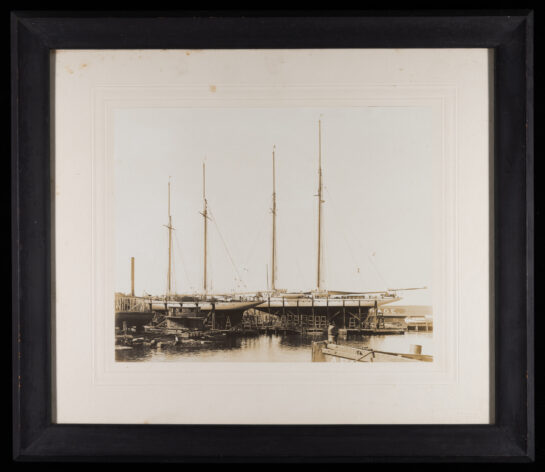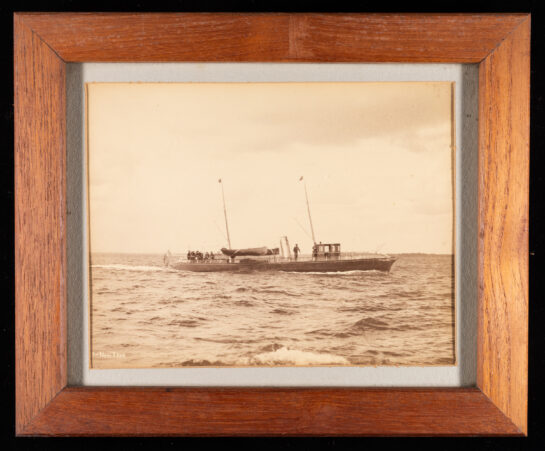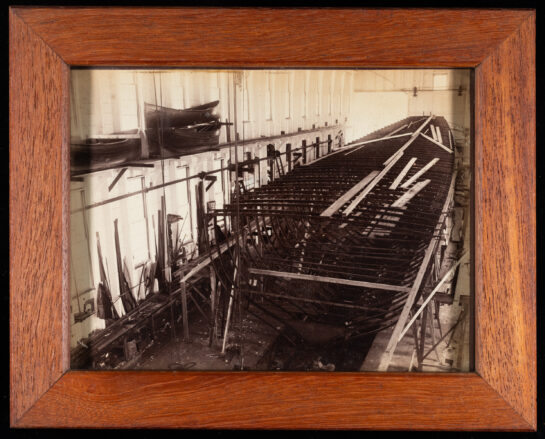Spotlight on The Love Rocks Picture Gallery:
A Selection of Historic Photos from Captain Nat's Home
What follows is a selection of historic framed photographs that originally belonged to Captain Nat (1848-1938) and hung in his home, Love Rocks, until the Herreshoff family sold the house in 1954. More than 45 of these photos are now on display in the ARIA Gallery at the Herreshoff Marine Museum. A small number have been re-framed, but most are in their original mounts and many bear Captain Nat or other family members' handwritten annotations on the back. We present scans of a small selection here, including the backs, which have their own visual interest and often provide additional detail. We encourage you to visit the Love Rocks Picture Gallery next time you are at the museum.
The great schooners VAGRANT (HMCo. #698) and KATOURA (HMCo. #722) in drydock. KATOURA of 1914 was the largest sailing vessel ever built by HMCo., with a length over all of 162'. KATOURA was built for repeat Herreshoff customer, Robert Tod, who was a dear friend of N.G.H.'s. There are many intricate classical joiner details depicted on KATOURA's drawings by N.G.H. in the archive at MIT. KATOURA and VAGRANT competed against each other, and here were photographed hauled out together at Thames Shipyard in New London.
The 1891 GLORIANA (HMCo. #411) in dry dock with a nattily dressed spectator looking on. The 46-footer (so-called for the waterline length) was a legend, winning eight races its first season out. N.G.H. built the hull using light, bulb-angle frames of steel, diagonally strapped them with thin bands, also of steel, to avoid wracking, then bolted-on the planking—single thickness on the bottom and double for the topsides. With a wooden backbone (keel, stem, and sternpost), it was known as composite construction, halfway between all-wood and all-steel. By 1891, N.G.H. had already begun using this technique successfully for his long and lean steamers.
NOW THEN (HMCo. #142) was so fast and so slippery that the yacht averaged more than 24 mph on the long run from Newport to New York. The steam yacht’s owner, newspaperman Norman Munro, got no takers when he challenged any other owners with steamers to a race without handicap. Although stylishly streamlined, NOW THEN’s sleek pointed stern soaked the passengers whenever the yacht backed into waves, so the Herreshoffs never used the feature again. Note Captain Nat's annotation on the verso, and thrifty use of an envelope for a paper backing for this frame.
WAVE (HMCo. #261) was a combination ferry and fire boat built for the U.S. Navy in 1907. On December 10, 1907 the Bristol Phoenix reported: “The new Government ferry boat, which has just been built at the Herreshoff Manufacturing company's boat shop in this town, will be launched tomorrow at high tide. Yesterday several government officials came up from Newport in a government tug-boat and inspected the new boat, which will ply between Newport and the Torpedo station, and also be used as a fire patrol boat along the water front… The craft is of the double-ended style, and is 82 feet, 8 inches long, over guards, has a beam of 25 feet and draught of six feet. She has a compound engine, driving propeller screws at either end, and is to have a speed of 8 1/2 knots, which is quite sufficient for the needs of use in the harbor…” In this photo however, it is the fire stream that is propelling the ferry at a brisk 2 1/2 knots, per N.G.H.’s annotation!
HMCo.'s first big yacht of riveted steel was equipped with an N.G.H.-designed five-cylinder, quadruple-expansion steam engine in 1888. BALLYMENA’s speed was around 20 mph. Named after the owner's ancestral northern Irish hometown, this handsome vessel made a big splash as the largest and most elegant HMCo. steamer yet built. At 148 feet long, came in the fall of 1888 for Baltimore banker George S. Brown. In this photo of BALLYMENA under construction, you can also see Agnes Herreshoff's canoe 1884 INEZITA (“Little Agnes”), stored in the upper left above the rowboat.
The 1887 CLARA (HMCo. #402) succeeded the smaller CONSUELO after N.G.H. regretfully sold that boat, some three years after marrying Clara DeWolf. This new cruiser was designed, built, and launched only four months later, in August, with fully-battened sails instead of conventional gaff-rigged ones. A rectangular many-windowed trunk cabin (which became a signature HMCo. feature) gave light below and allowed lower freeboard. After being re-rigged as a cutter by subsequent owners and migrating to the West Coast, CLARA returned, was restored, and is now on exhibit here in the Hall of Boats at HMM. This photo was evidently part of the exhibit staged at the Wadsworth Atheneum in Hartford, Connecticut, celebrating Captain Nat’s legacy in 1944 as indicated by the inventory label in the upper right hand corner on the verso.
This photo of SHEERNESS (HMCo. #1074s) during its 1928 launching at HMCo. is the only print in the set of nearly 50 photos from Love Rocks now on display that shows a vessel not designed by Captain Nat. The fact that he kept it alongside the others might suggest a certain regard for the boat and/or the designer, long-time HMCo. employee, Charles Nystrom, possibly with input from Captain Nat’s son, A. Sidney deWolf Herreshoff. SHEERNESS was an L-boat with an auxiliary engine, and measured in at 82’ over all.
This signed James Burton photo shows the 1906 128’ steel schooner yacht QUEEN (HMCo. #657) squaring off with the A. Cary Smith designed ELMINA. The little that remains of the note in Captain Nat’s handwriting on the verso (“…room starb. forward”) suggests this photo may have hung on a Herreshoff family yacht, likely either ROAMER (HMCo. #215) or HELIANTHUS (HMCo. #288).
















